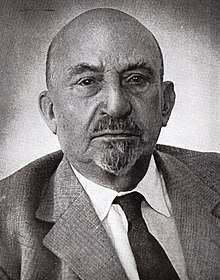Technische Universität Darmstadt
The Technische Universität Darmstadt (official English name Technical University of Darmstadt[4], sometimes also referred to as Darmstadt University of Technology), commonly known as TU Darmstadt, is a research university in the city of Darmstadt, Germany. It was founded in 1877 and received the right to award doctorates in 1899.[5] In 1882, it was the first university in the world to set up a chair in electrical engineering. In 1883, the university founded the first faculty of electrical engineering and introduced the world's first degree course in electrical engineering.[6][7] In 2004, it became the first German university to be declared as an autonomous university.[8] TU Darmstadt has assumed a pioneering role in Germany. Computer science, electrical engineering, artificial intelligence, mechatronics, business informatics, political science and many more courses were introduced as scientific disciplines in Germany by Darmstadt faculty.[6][9][10][11][12]
Technische Universität Darmstadt | |
 Athena, goddess of wisdom and strategy | |
Former names | Technische Hochschule Darmstadt |
|---|---|
| Type | Public |
| Established | 1877[1] |
| Budget | €454.3 million (2018)[2] |
| President | Tanja Brühl[3] |
Academic staff | 2,593[2] |
Administrative staff | 1,909[2] |
| Students | 25,889[2] |
| Location | , , 49.874995°N 8.656517°E (inner city) 49.86113°N 8.68056°E (Lichtwiese) |
| Campus | Urban/Suburban |
| Affiliations | |
| Website | www.tu-darmstadt.de |
TU Darmstadt founded the IT-Cluster Rhine-Main-Neckar, the "Silicon Valley of Germany". The Johannes Gutenberg University Mainz, the Goethe University Frankfurt and the Technische Universität Darmstadt together form the Rhine-Main-Universities (RMU). TU Darmstadt is a member of TU9, a network of the most notable German Technische Universitäten (universities of technology) and of the Top Industrial Managers for Europe network, which allows for student exchanges between leading engineering schools.
According to the German Research Foundation, TU Darmstadt is the best university in Germany for computer science. The university received the highest number of competitive grants in the field of computer science from the German Research Foundation and thus ranked first.[13] TU Darmstadt together with the German Research Center for Artificial Intelligence were selected as partner of the German "Federal Government's Artificial Intelligence (AI) Strategy".[14] TU Darmstadt operates the ATHENE, the largest research institute for cybersecurity in Europe.[15]
Graduates of TU Darmstadt include Nobel Prize winners, entrepreneurs, managers, billionaires and politicians. As of September 2019, the university is associated with 4 Nobel laureates and 3 Wolf Prize in Physics laureates. For several years, TU Darmstadt has been one of the universities with the most top managers in the German economy. The university is currently among the top 3.[16][17] The graduates include Oliver Zipse, Peter Grünberg, Chaim Weizmann and John Tu. Nobel laureate Albert Einstein recommended this university.[18]
Since 2013, 95 companies have been founded in the vicinity of the university.
History
.jpg)
On 10 October 1877, Louis IV, Grand Duke of Hesse, elevated the Polytechnische Schule to Technische Hochschule zu Darmstadt and thereby raised the status of this educational institution to that of a university so that the Abitur (a school leaving certificate from German Gymnasium schools qualifying for university admission or matriculation) became a requirement for admissions.[19] In 1899, the Technische Hochschule Darmstadt was granted the right to award doctorates.[20][21][22]
Early beginnings
The University's history is varied: its early phases began with the Höhere Gewerbschule (Higher Trade School), which was founded in 1836 and received its own building near the 'Altes Pädagog' on Kapellplatz in 1844, followed by the Technische Schule (Technical School) in 1864 and the Großherzoglich Hessische Polytechnische Schule (Grand Ducal Hessian Polytechnic) in 1868. At that time, heated discussions were continually held in political circles on the issue as to whether such a poor state as the Grand Duchy of Hessen could afford a technically oriented higher educational institution, or even a polytechnic. After the foundation of Technische Hochschule Darmstadt in 1877, student numbers kept on being so low that in the years from 1881 to 1882 there were long debates in public about closing down the university. In this difficult situation, the local government and the university made the courageous decision to set up the first chair of electrical engineering worldwide. Thus the Faculty of Electrical Engineering came into being as the sixth faculty of the Technische Hochschule Darmstadt, which was a novelty in academia, because until then no other university had had such a faculty. This forward-looking higher education policy paved the way for Darmstadt to take up a leading position in the rapidly developing field of electrical engineering, which in turn led to a continuously rising number of students, so that the closure of the university never was demanded again.[23][22][24]
First steps as a university
In 1895, new buildings were opened in Hochschulstrasse: the Altes Hauptgebäude (the 'Old Main Building' of the University) and an institute building directly opposite. During the two decades before the World War I, all disciplines of the university underwent diversification and expansion. New disciplines such as paper making and cellulose chemistry were introduced, and as early as 1913 a Chair of Aeronautics and Flight Mechanics was set up.[22][25]
Meanwhile, the political climate had become stormier, and a growing political polarization exploded in Darmstadt over the question of foreign students. The Technische Hochschule Darmstadt had an extraordinarily large number of foreign students. In 1906, for instance, as many as three-quarters of the electrical engineering students were from abroad, mainly from states of eastern Europe.[22]
After the World War I there was an urgent need for reform of the education system at Technische Hochschule Darmstadt, which was seen as a prerequisite for meeting the requirements of a modern industrial society. Intense discussions were held on the aim of extending the curriculum beyond the purely technical education in order to prepare the engineer for his leading role in society. A concrete step in this direction was taken in 1924, when the 'General Faculty', which until then had combined all the non-technical subjects, was divided into a Department of Mathematics and Natural Science and a Department of Cultural Studies and Political Science. Moreover, the measures taken to provide students with knowledge outside their own field of study included the upgrading of Economics and the creation of professorships in political science, history of technology and sociology.[22][23][24][26]
Restart after WW II

On the night of 11/12 September 1944, eighty per cent of the city, including many of the university's buildings, were destroyed during a bomb attack. For a short period in 1945, parts of the TH Darmstadt may have been closed by decree of the Allies before it was reopened in 1946. The electrical engineering department remained continuously functional, doing work under contract with the U.S. Army to build components of the V-2 guidance system. "But we have to be careful how we word this production order because we don't want the Russians to know that we are cranking up the V-2 system."[27] In spite of the difficult post-war situation, university staff and students alike managed to settle down to university work in the severely damaged buildings, which had to be used as a makeshift solution.[26]
As early as 1947, Technische Hochschule Darmstadt hosted the first Internationaler Kongress für Ingenieurausbildung (International Congress on Engineering Education), at which the participants discussed the moral responsibility of the technical intelligentsia and of the scientific elite in politics and society. In view of the disastrous consequences of the war, the participants (with the exception of the Americans, who had already contracted with THD faculty to continue weapon development), committed themselves henceforth to do research and teaching in engineering and scientific disciplines solely for the peaceful development of mankind.[28][26][22]
- Technical Science as Ethical and Cultural Task.
- Present State and Tendencies of Development in Engineering Education Throughout the World.
- Selection of Students and Social Problems.[29]
The speech delivered by Dr. James R. Newman, Director of American Military Government of Hessen, however, made no mention of such a commitment, while stating that:
"An interchange of these [past experience], together with ideas and methods of education along engineering lines, will aid greatly, not only in the reconstruction of battle torn countries, but also in the bringing about of a universal understanding and mutual respect, and the charity which have prevented the understanding, the tolerance, the respect, and the charity so necessary for the peace, happiness, and contentment that is the dream of every human being on this earth."[30]
The post-war period of reconstruction was largely based on a major development programme in the 1960s, by means of which universities and the state reacted to the continuously rising numbers of students. Since almost no land was available in the city centre for new construction projects, the decision was taken in 1963 to use the 'Lichtwiese' (a former airfield on the outskirts of the city) as a site for building extensions to the Technische Hochschule. Thus in the late 1960s and in the early 1970s numerous buildings, including a new student cafeteria, were erected there and ultimately became the university's second campus.[22][22]
University reforms in the 1970s
After 1968 the university reform, having been initiated by the student movement, was beginning to take shape both at a national and a regional level. It aimed at creating clear university structures and the involvement of all university members in decision-making processes. In 1970 the Hessisches Hochschulgesetz (Higher Education Law of the Federal State of Hessen) came into force. These gave Technische Hochschule Darmstadt, along with other Hessian universities, a new structure based on the introduction of a presidential statute and a unified administration as well as the subdivision of the university structure into departments.[22][31][32]
In the mid 1970s, there was another rapid rise in student numbers. Staff development, however, lagged far behind, resulting in inevitable restrictions on admission imposed either by the central government or by the University. Regardless of the staff's heavy workload, the TH Darmstadt managed to set the course for the future, as evidenced by the School of Information Science, established in 1974, the Zentrum für Interdisziplinäre Technikforschung (Centre for Interdisciplinary Studies on Technology), founded in 1987, and the Department of Materials Science, established in 1989. This department has been housed in a new building on the Lichtwiese since 1996.[22][32]
Renaming
By the end of the 20th century, Technische Hochschule Darmstadt had been granted the legal status of a university, and had been offering a correspondingly wide range of subjects, for over a hundred years. For these reasons, and also with the objective of sharpening public awareness of the university's status at home and abroad, Technische Hochschule Darmstadt was renamed Technische Universität Darmstadt (which is also its official English name albeit often called Darmstadt University of Technology) on 1 October 1997. This name change was partly prompted by misunderstandings that had occurred in English-speaking countries, where Technische Hochschule had often been mistakenly transliterated as 'Technical High School', providing a totally misleading connotation.[22][24]
Autonomy and TUD Law
On 1 January 2005, the first version of the TUD Law applied making TU Darmstadt the first German public university to be given administrative autonomy.[19] New administrative structures were put into place, and their success is being evaluated. For instance, the university can now autonomously administer its budget and buildings. Also, the university can hire professors and negotiate their salaries by itself. Formerly this was done by the State of Hessen. The status of autonomy also allows TU Darmstadt to invest in business start-ups.[33] The Technische Universität Darmstadt is the only German university that has legally committed itself to guarantee their students good studying conditions.[34][35] The TUD law in its current state has legal force up to 31. December 2020.[33]
The university as a pioneer
In 1882, the Technische Hochschule Darmstadt was the first university in the world to set up a chair for electrical engineering and founded the first faculty for it in 1883.[7][6] The first chair holder was Erasmus Kittler.[36] In the same year the university introduced the world's first course of study in electrical engineering.[6]
In 1913, the university set up the first chair for aviation and aircraft technology in Germany.[37] The TH Darmstadt set up the first chair for scientific policy in 1951.[38] The first chair holder was Eugen Kogon. He is considered one of the founders of political science in Germany.
The TH Darmstadt shaped the subject of corporate governance in Germany. In 1973, the university established the first chair for management control system in Germany. The first chair holder was Péter Horváth, founder of Horváth & Partners.[39][40]
In Germany, the beginnings of computer science go back to the Institute for Practical Mathematics of the TH Darmstadt, which the mathematician Alwin Walther built in early 1928.[12] In 1956, the first programming lectures and internships in Germany were offered at the TH Darmstadt.[12] Due to the reputation that the TH Darmstadt had at the time in computer science research, the first international congress on computer science held in German-speaking countries took place in October 1955 at the TH Darmstadt.[12] Robert Piloty, professor at the TH Darmstadt, developed the computer science courses in Germany.[12] In 1968, the TH Darmstadt introduced the first degree course in computer science in Germany and in 1975 the first degree course in business informatics.[12]
Artificial intelligence as a scientific field in Germany and Europe was founded by Wolfgang Bibel, professor of intellectics at TU Darmstadt.[12] He set up a research group for artificial intelligence at the TH Darmstadt in 1988.[41] In 1996, the first chair in Germany for renewable energies was set up at TH Darmstadt and staffed with Thomas Hartkopf.[42]
In 2004, it became the first German university to be declared as an autonomous university.[8]
Academic profile
Departments
Typical for a university of technology, ten out of its 13 academic departments (Fachbereiche) are in engineering, natural sciences, and mathematics, while three departments are in the social sciences and the humanities. The departments (with number of the department) are:[43]
- Department of Law and Economics (1)
- Department of History and Social Sciences (2)
- Department of Human Sciences (3)
- Department of Mathematics (4)
- Department of Physics (5)
- Department of Chemistry (7)
- Department of Biology (10)
- Department of Materials and Earth Sciences (11)
- Department of Civil and Environmental Engineering (13)
- Department of Architecture (15)
- Department of Mechanical Engineering (16)
- Department of Electrical Engineering and Information Technology (18)
- Department of Computer Science (20)
Fields of study
There are five fields of study (Studienbereiche), which offer interdisciplinary degree courses in which students take lectures in multiple departments:[43]
- Computational Engineering
- Energy Science and Engineering
- Information Systems Engineering
- Mechanics
- Mechatronics
TU Darmstadt offers about 100 courses of studies.[44] Beyond Bachelor's and master's degrees, it also offers degree courses for teaching positions at German vocational schools and gymnasiums.[45]
Research profile
TU Darmstadt defined six profile areas which characterize its research profile:[46]
Research
At TU Darmstadt there are several Sonderforschungsbereiche (SFB, collaborative research units)[53] as well as several Graduiertenkollegs (graduate schools)[54] that are funded by Deutsche Forschungsgemeinschaft. The university has attracted a considerable number of national and international research institutions to the Wissenschaftsstadt Darmstadt (Darmstadt – City of Science). Among them are:
- GSI Helmholtz Centre for Heavy Ion Research (GSI)
- Fraunhofer Institute for Secure Information Technology SIT[55]
- Fraunhofer Institute for Computer Graphics Research IGD[56]
- Fraunhofer Institute for Structural Durability and System Reliability[57]
- European Space Operations Centre (ESOC)
- European Organisation for the Exploitation of Meteorological Satellite (EUMETSAT).
- ATHENE
TU Darmstadt collaborates with these research institutes on a broad basis. For instance, TU Darmstadt and GSI agreed on a strategic partnership, which includes collaboration in the establishment of the FAIR Facility for Antiproton and Ion Research.[58]
The European Space Agency has set up a research laboratory at TU Darmstadt, ESA_LAB@TU Darmstadt. It is the first research laboratory the European Space Agency has set up at a German university.[59][60]
In 2018, TU Darmstadt has won the competition of the European Institute of Innovation and Technology (EIT) and is building an Institute for Manufacturing together with 50 partners including Siemens, Volkswagen, KUKA, German Research Center for Artificial Intelligence and Volvo. There will be an EIT Manufacturing Innovation Hub at the university.[61][62]
TU Darmstadt is involved in the German Excellence Initiative. This initiative sponsored the Cluster of Excellence Smart Interfaces (2007–2014), the Graduate School of Computational Engineering and the Graduate School of Excellence Energy Science and Engineering. TU Darmstadt is also partially involved with the Cluster of Excellence Normative Orders, based at Goethe University Frankfurt.[63]
Cooperation with companies
The Technische Universität Darmstadt maintains several research collaborations with companies and research institutions. These include, for example:
- PRORETA, a research collaboration with Continental AG, whose goal is to develop driver assistance systems that avoid traffic accidents.[64]
- Intel Collaborative Research Institute for Secure Computing (ICRI-SC), a joint institute of the Technische Universität Darmstadt and Intel, which deals with the security of system-on-a-chip platforms.[65] It is the first Intel collaborative research center for IT security outside the USA.[66]
- Intel Collaborative Research Institute for Collaborative Autonomous & Resilient Systems (ICRI-CARS), a joint institute of the Technische Universität Darmstadt and Intel to study the security, privacy and safety of autonomous systems that collaborate with each other.[67]
- SAP Research, a cooperation with the software manufacturer SAP, which conducts research in various fields.[68]
TU Darmstadt is also a member of the Competence Center for Applied Security Technology (CAST), the largest corporate network for cybersecurity in German-speaking countries.[69][70]
Strategic partnerships
The Technical University distinguishes between strategic alliances, a cooperative lab and a TU Darmstadt cooperation institute in strategic partnerships.[71]
TU Darmstadt maintains strategic alliances with the companies Merck, Deutsche Bahn, Continental, Robert Bosch GmbH and Siemens.[71]
Cooperative Labs are research laboratories that are operated together with the partner and, as a rule, on the grounds of TU Darmstadt. The labs conduct joint and interdisciplinary research into a defined but broad subject area.[71] Together with Merck, TU Darmstadt operates the Merck Lab, which has been investigating novel inorganic composite materials since 2006 that are suitable as printable components for electronic applications.[71]
Selected strategic partnerships can also receive the status of a TU Darmstadt cooperation institute from the university management.[71] Since 2012, the first TU Darmstadt cooperation institute has been the DB Schenker Lab, whose goal is to expand joint research in the fields of transport and logistics and to additionally create relevant offers in the fields of teaching, training and university marketing.[71]
Knowledge transfer and business start-ups
TU Darmstadt has the innovation and start-up center HIGHEST (Home of Innovation, GrowtH, EntrepreneurShip and Technology Management). HIGHEST supports the development of a business model, the identification of suitable funding programs, networking with mentors, companies and investors, offers lectures and seminars on the subject of innovation and entrepreneurship and provides contact persons. In addition, there are labs at TU Darmstadt on various subject areas in which one can experiment or simply exchange ideas. The autonomy status also enables TU Darmstadt to participate in business start-ups with its own funds. In a competition, TU Darmstadt was honoured by the Federal Ministry for Economic Affairs and Energy as a founding university. The university is regarded as a role model when it comes to making start-up processes fast, simple and transparent. Since 2013, 95 knowledge- and technology-based companies have been founded in the vicinity of TU Darmstadt.[72] The Startup & Innovation Day takes place once a year, where startups from the founding scene of the Rhine-Main-Neckar region present their innovations from a wide variety of areas and development stages.[73] For cooperation with companies, TU Darmstadt set up a collaboration with Hessenmetall, the regional association of the machinery, electronic and automotive industry.[74]
High-performance computer
The Technische Universität Darmstadt is one of the few German universities that have a high-performance computer.[75] The high-performance computer Lichtenberg is named after Georg Christoph Lichtenberg and has a computing power of about 1 PetaFLOPS.[76] For comparison, the currently fastest high-performance computer Summit owns 148.6 PetaFLOPS (as of June 2019). In 2015 Lichtenberg was listed in the TOP500 at rank 410.[77] In 2017, TU Darmstadt received 15 million euros from the federal government and state for the expansion of the Lichtenberg high-performance computer, the Lichtenberg II.[78][79] This should have more than twice the power.[79][80] Lichtenberg II will be used especially in the field of computational engineering, which is a profile topic of TU Darmstadt.
TU Darmstadt is also a member of the Competence Center for High Performance Computing in Hessen (HKHLR), an association of the Goethe University Frankfurt am Main, the Justus Liebig University Giessen, the Philipps University Marburg, the University of Kassel and the Technische Universität Darmstadt.[81] Each of the members has a high-performance computer.[81] As a voting member TU Darmstadt represents Hessian interests in the Gauß-Allianz, the union of all supercomputers at the state level in Germany.[81]
Robotics
The Technische Universität Darmstadt (TU Darmstadt) is also internationally known for its robot research. The search and rescue robot Hector (Heterogeneous Cooperating Team Of Robots), developed by the department of computer science, competed in the Rescue Robot League 2014 of RoboCup, the oldest and world's largest competition for intelligent robots in various application scenarios, and won the first place.[82] The robot Hector won 1st place in the category Best in Class Autonomy, the most intelligent robot, in the Rescue Robot League in the years from 2012 to 2015 and 2018 to 2019.[83][84]
In 2015, a team around Oskar von Stryk competed in the DARPA Robotics Challenge. The team made it to the final with two robots in two different teams Hector and ViGIR. Team Hector competed with the robot Johnny 05 and Team ViGIR with the robot Florian.[85][86][87]
In 2017, the Argonaut robot, developed by a team led by Stryk, won the ARGOS Challenge for intelligent inspection robots on oil and gas platforms, which the company Total S.A. had launched. The prize was half a million euros. Argonaut is a variant of Taurob tracker and the first fully autonomous, mobile inspection robot for oil and gas plants.[88][89]
In 2018, Hector competed at the World Robot Summit in Tokyo in the Plant Disaster Prevention Challenge and won 1st place.[90] The research team of Stryk has been building the German Rescue Robotics Centre since 2018.[91]
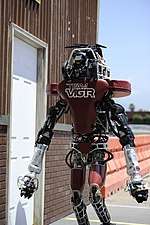 Robot Florian at the DARPA Robotics Challenge 2015
Robot Florian at the DARPA Robotics Challenge 2015 Robot Johnny 05 at the DARPA Robotics Challenge 2015
Robot Johnny 05 at the DARPA Robotics Challenge 2015 Robot Argonaut at the ARGOS Challenge
Robot Argonaut at the ARGOS Challenge Hector UGV identifies a victim using a probabilistic world model, based on information from heterogeneous sensors
Hector UGV identifies a victim using a probabilistic world model, based on information from heterogeneous sensors
Campuses
The University, with 164 Buildings and an area of property of 600 acres (2.4 km2),[2] is concentrated at the two campuses, Inner City and Lichtwiese. But individual facilities can be found in other parts of Darmstadt and in Griesheim, a neighboring town.[92]
Inner City Campus
This campus lies very central in Darmstadt and is easily reachable by tram and bus from every part of the city. The departments located here are Electrical Engineering and Information Technology (18), History and Social Sciences (2), Human Sciences (3), Computer Science (20), Mathematics (4), Physics (5) and Law and Economics (1).[93]
 Robert Piloty Building, named after Robert Piloty, a German computer scientist and Professor of Electrical Engineering at TU Darmstadt, used by the Department of Computer Science, 2006
Robert Piloty Building, named after Robert Piloty, a German computer scientist and Professor of Electrical Engineering at TU Darmstadt, used by the Department of Computer Science, 2006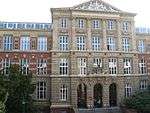 Altes Hauptgebäude of Technische Universität Darmstadt, 2008
Altes Hauptgebäude of Technische Universität Darmstadt, 2008 Kantplatz, Darmstadt, 2007
Kantplatz, Darmstadt, 2007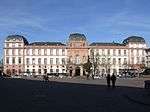 Darmstadt former Ducal Palace, now part of TU Darmstadt, with market square
Darmstadt former Ducal Palace, now part of TU Darmstadt, with market square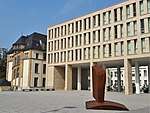 Campus Square, Inner City Campus of TU Darmstadt, with University Library and sculpture "Bueste" by Franz Bernhard
Campus Square, Inner City Campus of TU Darmstadt, with University Library and sculpture "Bueste" by Franz Bernhard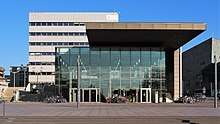 Main Entrance and Administrative Building, City Campus TU Darmstadt 2018
Main Entrance and Administrative Building, City Campus TU Darmstadt 2018
Campus Lichtwiese
The Lichtwiese lies in the eastern part of Darmstadt. It is reachable by bus and a nearby train station. The departments located here are Architecture (15), Civil Engineering and Geodesy (13), Chemistry (7), Mechanical Engineering (16) and Materials and Earth Sciences (11).[94]
 Canteen at Campus Lichtwiese, 2007
Canteen at Campus Lichtwiese, 2007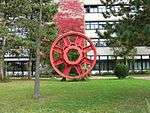 Giant gear in front of the mechanical engineering building, 2007
Giant gear in front of the mechanical engineering building, 2007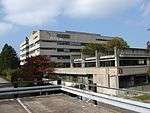 Building used by the Department of Architecture, 2007
Building used by the Department of Architecture, 2007 Institute of Materials Science, TU Darmstadt Lichtwiese Campus
Institute of Materials Science, TU Darmstadt Lichtwiese Campus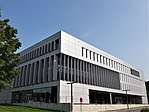 Lecture Halls and Library Building at Lichtwiese Campus
Lecture Halls and Library Building at Lichtwiese Campus
Botanical garden
The Botanical Garden of TU Darmstadt is located near the Lichtwiese Campus and the Department of Biology (10) is located here as well. With additional buildings of the Department of the Materials and Earth Sciences (11)[95] and parts of the faculty of Chemical Engineering and Biotechnology of the Darmstadt University of Applied Sciences (h_da)[96] it makes for an additional smaller campus.
- Greenhouse, 2009
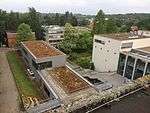 Botanical Garden Campus of TU Darmstadt
Botanical Garden Campus of TU Darmstadt
Griesheim
Since 2005, TU Darmstadt owns the August Euler Airfield, Germany's oldest airfield, for scientific purposes. It is named after its founder August Euler, a pioneer aviator.[97] The airfield is not only used to start planes, but also to conduct research on topics where wide spaces are needed, for example driver assistance systems and automotive lighting are being tested here.[98] Located near the airfield are the wind tunnels of TU Darmstadt.[99]
_AN2005697.jpg) August Euler Airfield, 2011
August Euler Airfield, 2011
Internationality
With 18% (2017),[44] the percentage of international students at TU Darmstadt is clearly higher than the average of German universities of 13% (2017/18).[100] TU Darmstadt maintains partnership agreements with over 300 universities in 53 countries world-wide, which enable students to come to TU Darmstadt and to go abroad within their course of studies.[101][102] For example, the Technische Universität Darmstadt has partnerships with the Massachusetts Institute of Technology, University of California, Berkeley, Katholieke Universiteit Leuven, Nanyang Technological University, Tsinghua University and Seoul National University.[103] With Tongji University Shanghai, Virginia Polytechnic Institute and State University and Graz University of Technology, TU Darmstadt has developed strategic partnerships.[104]
The Technische Universität Darmstadt has been awarded the title "European University" by the European Commission. Together with 6 other European technical universities, TU Darmstadt has formed the alliance UNITE! (University Network for Innovation, Technology and Engineering). The aim of the project is to create a trans-European campus, to introduce trans-European curricula, to promote scientific cooperation between the members and to strengthen knowledge transfer between the countries. The alliance includes Aalto University, the Royal Institute of Technology, the National Polytechnic Institute of Grenoble, the Polytechnic University of Turin, the Polytechnic University of Catalonia and the University of Lisbon.[105]
The university offers international (English-language) Master's programs[106] and a broad range of double degree programs.[107] The Joint Master Programme "International Cooperation in Urban Development (Mundus Urbano)" is offered together with Université Pierre Mendès-France, International University of Catalonia, and Universita degli Studi di Roma Tor Vergata as part of the Erasmus Mundus programme of the European Commission.[108]
TU Darmstadt is a member of the Conference of European Schools for Advanced Engineering Education and Research.[109][5]
Student life
Activities
TU Darmstadt offers various recreational sports courses and operates three sports halls, a sports stadium including various fields, a swimming pool, and a fitness studio. TU Darmstadt won the university competition of the German Olympic Sports Confederation for the third time in succession and has since been awarded the title of the most athletic university in Germany.[110] There are manifold accredited student groups, ranging from the Formula SAE TU Darmstadt Racing Team (DART), TU Darmstadt Space Technology (TUDSaT), Akaflieg Darmstadt, and Chaos Computer Club to a theater group, an orchestra, and the campus radio AudioMax.[111] The annual job fair konaktiva, which connects approximately 10,000 students with potential employers, is organized by volunteer students.[112]
Students' representation
Students at TU Darmstadt are represented by the students' parliament (Studierendenparlament, StuPa), which is elected annually and in turn elects the General Students' Committee (Allgemeiner Studierendenausschuss, AStA). The AStA is the students' government and engages in university politics and provides social and economic counseling for students. Moreover, it runs the café 60,3qm ("60.3 square meters"), a beer garden and a club in the Ducal Palace, a store for office supplies, and a bicycle garage. In addition to the regular university curriculum, students can attend various non-credit courses held by students and coordinated by the AStA.
Complementing the General Students' Committee, which represents all students enrolled at TU Darmstadt, the students of each department (Fachschaft) are represented by an elected students' council (Fachschaftsrat). Students of the Fachschaft participate in a number of committees of their department, such as the department's council (Fachbereichsrat), which consists of professors, students, academic staff and administrative staff.
Legends
Since the 1970s, the fictitious student Fritz Filter passed numerous examinations at the Department of Architecture before graduating with a Diplom degree in 2004. His thesis featured the design of the department building. Fritz Filter turned in multiple further architecture theses since then.[113]
Housing
According to a survey determined in 2016, students in Darmstadt paid an arithmetic mean of 348 euros a month for rent, heat and utilities. With the German average being 323 euros at the time, this made Darmstadt the ninth most expensive city for students in Germany.[114] This value only includes students who live alone, are not married and are pursuing their first degree.[115] In 2016, on national average, approximately 20% lived with their parents, 12% lived in a hall of residence, 1% were lodgers, 30% were sharing a flat with others, 17% were living alone and 21% were sharing a flat with their partner.[114] There are about 2600 beds in 10 halls of residence offered by the state-run student affairs organization Studierendenwerk Darmstadt for students of TU Darmstadt and the Darmstadt University of Applied Sciences.[116]
Reputation and ranking
| University rankings | |
|---|---|
| Global – Overall | |
| ARWU World[117] | 501–600 (2019) |
| THE World[118] | 251–300 (2020) |
| USNWR Global[119] | 497 (2020) |
| QS World[120] | 260 (2020) |
Within Germany and Europe, TU Darmstadt (in the overall ranking) and its faculties (in individual grades) regularly occupy top positions in rankings.
For several years, TU Darmstadt has been one of the universities with the most top managers in the German economy. The university is currently among the top 3.[16][17]
In the latest Humboldt-Ranking of the Alexander von Humboldt Foundation, TU Darmstadt takes first place in engineering.[121]
According to the research report 2018 of the German Research Foundation (DFG), which breaks down the grants for the period 2014 to 2016, TU Darmstadt received the highest grants of any German university in the field of computer science and the fourth highest grants in engineering.[13] In a competitive selection process, the DFG selects the best research projects from researchers at universities and research institutes and finances them.[122]
According to CSRankings, a ranking that makes it possible to evaluate the scientific achievements of universities in individual areas of computer science, TU Darmstadt is the leading university in Europe in the fields of cryptography, IT security and software engineering. In the fields of artificial Intelligence, robotics, machine learning, computer vision and computational linguistics, the university ranks second among European universities and first among German universities. It is one of the top 10 universities in Europe in all scientific fields of computer science.[123] CSRankings is one of three rankings that are recognized according to the criteria of the Computing Research Association (CRA). The CRA has defined four criteria: rankings should be based on "good" (clean and curated) data, the data should be transparent and available, and the methodology should be based on objective criteria. CSRankings aims to reflect the quality of research by relating the contributions of universities in selective conferences to the size of the university. This methodology should be less susceptible to manipulation than the measurement of citation. The methodology is transparent and accessible.[124]
In the university ranking 2018 of the German business magazine Wirtschaftswoche, TU Darmstadt is considered to be the best university for business informatics. In industrial engineering the university secures the 3rd place. In mechanical engineering and electrical engineering TU Darmstadt ranks 4th.
In the Research Ranking of the Association for Information Systems, TU Darmstadt ranks 16th in business informatics worldwide, 3rd in Europe after the Copenhagen Business School and London School of Economics and Political Science and 1st in Germany.[125]
According to the Stepstone salary report for graduates 2017, TU Darmstadt graduates earn the highest salary in engineering and information technology in Germany compared to graduates of other German universities.[126][127]
In the QS Graduate Employability Rankings 2019, TU Darmstadt ranked 3rd in Germany, 22nd in Europe and 78th in the world.[128]
According to the QS World University Rankings 2020, TU Darmstadt is one of the universities with the highest scientific impact in Germany and leads among the technical universities in Germany. It belongs to the top 25 universities in Europe with the highest scientific impact.[129]
According to Reuters, TU Darmstadt is among Europe's most innovative universities in 2019.[130]
Notable faculty and alumni
Nobel laureates
Nobel laureates, who studied, taught and researched at the TH/TU Darmstadt:
- Peter Grünberg, physicist and Nobel laureate in Physics (2007)
- Horst Ludwig Störmer, physicist and Nobel laureate in Physics (1988)
- Gerhard Herzberg, chemist, physicist and Nobel laureate in Chemistry (1971)
- Hermann Staudinger, chemist and Nobel laureate in Chemistry (1953)
Taught at TH/TU Darmstadt through Emanuel Merck Lectureship:
- Frances H. Arnold, chemist and Nobel laureate in Chemistry (2018)[131][132]
- Harold Kroto, chemist and Nobel laureate in Chemistry (1996)[132]
- Jean-Marie Lehn, chemist and Nobel laureate in Chemistry (1987)[132]
- Manfred Eigen, chemist and Nobel laureate in Chemistry (1967)[132]
Other Nobel laureates are associated with the university:
- Gerhard Ertl, chemist and Nobel laureate in Chemistry (2007)
- K. Alex Müller, physicist and Nobel laureate in Physics (1987)[133]
- Karl Ziegler, chemist and Nobel laureate in Chemistry (1963)[134]
- Otto Hahn, chemist and Nobel laureate in Chemistry (1944)[135]
- Carl Bosch, chemist, engineer and Nobel laureate in Chemistry (1931)[133]
- Richard Willstätter, chemist and Nobel laureate in Chemistry (1915)[135]
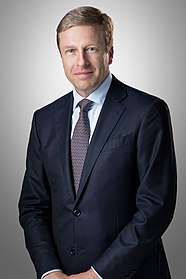
Economy
- John Tu, founder of Kingston Technology and billionaire
- Vikram Lal, founder of Eicher Motors and billionaire
- Peter Schnell, founder of Software AG
- Enis Ersü, founder of ISRA VISION AG
- Péter Horváth, founder of Horváth & Partners
- Detlev Riesner, founder of QIAGEN
- Hans Dieter Pötsch, Chairman of the Board of Management and Chairman of the supervisory board of Porsche SE
- Oliver Zipse, Chairman of the Board of Management of BMW AG
- Christoph Franz, Chairman of Hoffmann-La Roche AG
- Carsten Kratz, Managing Director & Senior Partner of the Boston Consulting Group
- Marcus Kuhnert, Member of the Executive Board and Chief Financial Officer of Merck of Merck
- Kai Beckmann, Member of the Executive Board & CEO Performance Materials of Merck
- Tobias Meyer, Member of the Board of Management of Deutsche Post AG
- Nicolai Setzer, Member of the Executive Board of Continental AG
- Werner Steinmüller, Member of the Executive Board of Deutsche Bank
- Wolfgang Bernhard, former member of the Board of Management of Daimler AG
- Hans Demant, former Chairman of Adam Opel GmbH
- Karl-Friedrich Rausch, Member of the Executive Board of Deutsche Bahn AG
- Bert Rürup, former Chairman of the German Council of Economic Experts
- Udo Steffens, former President and CEO Frankfurt School of Finance & Management
- Klaus-Dieter Vöhringer, former CEO of DaimlerChrysler AG
- Andreas Georgi, former Member of the Board of Management of Dresdner Bank AG
Historical personalities
- Chaim Weizmann, first President of Israel
- Karl Plagge, recognized as one of the Righteous Among the Nations
- Jovanka Bončić-Katerinić, first woman to obtain an engineering degree in Germany
- Günter Behnisch, architect of the Olympiastadion (Munich)
- Edmund Collein, east German architect and town planner
- Wolfgang Rösch, vicar general of the Diocese of Limburg
- Franz-Josef Kemper, Olympic medalist
- Gerhard Hennige, Olympic medalist
- Josef Ganz, Jewish automotive engineer and father of the original "Volkswagen"
.jpg)
Science
- Harald Rose, physicist and laureate of the Wolf Prize in Physics (2011)
- Maximilian Haider, physicist and laureate of the Wolf Prize in Physics (2011)
- Peter Grünberg, physicist and laureate of the Wolf Prize in Physics (2007)
- Georg Cantor, created the set theory
- Ernst Schröder, mathematician and known for his monumental lectures on the algebra of logic
- Lothar Collatz, mathematician and known for the still unsolved 3x + 1 problem
- William Prager, mathematician and known for Drucker–Prager yield criterion[136]
- Karl Hessenberg, known for the Hessenberg matrix
- Erwin Kreyszig, applied mathematician and distinguished author, having written the textbook Advanced Engineering Mathematics, the leading and most famous textbook for civil, mechanical, electrical, and chemical engineering undergraduate engineering mathematics.[137]
- Carl Adam Petri, mathematician and inventor of the Petri nets
- Sigurd Hofmann, physicist and discoverer of the chemical elements darmstadtium (Ds, atomic number 110), roentgenium (Rg, 111) and copernicium (Cn, 112)
- Peter Armbruster, physicist and discoverer of the elements 107 (bohrium), 108 (hassium), 109 (meitnerium), 110 (darmstadtium), 111 (roentgenium) and 112 (copernicium)
- Hans Busch, pioneer of electron optics and laid the theoretical basis for the electron microscope.
- Paolo Giubellino, Scientific Managing Director of the Facility for Antiproton and Ion Research and the GSI Helmholtz Centre for Heavy Ion Research
- Wolfgang Bibel, one of the founders of the research area of artificial intelligence in Germany and Europe
- Ottmar Edenhofer, lead author of the reports published by the Intergovernmental Panel on Climate Change which was awarded the Nobel Peace Prize (2007)
- Mohan Munasinghe, vice-chairman of the Intergovernmental Panel on Climate Change which was awarded the Nobel Peace Prize (2007)[138]
- Andreas Dreizler, mechanical engineer and Leibniz Prize laureate (2014)
- Rainer Waser, electrical engineer and Leibniz Prize laureate (2014)
- Lutz Raphael, historian and Leibniz Prize laureate (2013)
- Jürgen Eckert, engineer and Leibniz Prize laureate (2009)
- Jürgen Rödel, material scientist and Leibniz Prize laureate (2009)
- Johannes Buchmann, computer scientist, mathematician and Leibniz Prize laureate (1993)
- Randolf Menzel, zoologist and Leibniz Prize laureate (1991)
- Thomas Weiland, physicist and Leibniz Prize laureate (1988)
- Wolfram Saenger, biochemist and Leibniz Prize laureate (1988)
- Bernd Giese, chemist and Leibniz Prize laureate (1987)
- Frank Steglich, physicist and Leibniz Prize laureate (1986)
- Eric Bodden, Heinz Maier-Leibnitz-Preis laureate (2014)
- Stefan Roth, Heinz Maier-Leibnitz-Preis laureate (2012)
- Christina Thiele, Heinz Maier-Leibnitz-Preis laureate (2010)
- Torsten Granzow, Heinz Maier-Leibnitz-Preis laureate (2008)
- Nicole Deitelhoff, Heinz Maier-Leibnitz-Preis laureate (2008)
- Marc Alexa, Heinz Maier-Leibnitz-Preis laureate (2003)
- Carsten Bolm, Heinz Maier-Leibnitz-Preis laureate (1991)
- Alexandre Obertelli, Alexander von Humboldt Professorship of the Alexander-von-Humboldt-Stiftung (2019)
- Johann Dietrich Wörner, Director General of the European Space Agency
- Kurt H. Debus, rocket scientist and first Kennedy Space Center director
- Robert Piloty, pioneer of computer engineering and one of the founding fathers of computer science courses in Germany
- Peter Mertens, one of the founding fathers of business informatics courses in Germany
- Marc Baldus, physicist and professor of structural biology at Utrecht University
- Hanns-Peter Boehm, chemist and a pioneer of graphene research
- Sabine Brunswicker, professor for digital innovation and the Founder and Director of Research Center for Open Digital Innovation (RCODI)
- Friedrich Dessauer, pioneer of X-ray technology
- Mikhail Dolivo-Dobrovolsky, inventor of the three-phase electrical motor
- José Luis Encarnação, inventor of the Graphical Kernel System
- Paul Friedländer, chemist
- Kurt Hohenemser, aerospace engineer and pioneer in helicopter design
- Karl Küpfmüller, electrical engineer
- El Lissitzky, architect and designer
- Ernst May, architect and city planner of New Frankfurt
- Ernst Neufert, architect
- Gustav Niemann, mechanical engineer
- Fritz von Opel rocket pioneer
- Frank Schimmelfennig, political scientist
- Bernhard Schlink, former judge and writer (The Reader)
- Ernst Schröder, mathematician
- Gerhard M. Sessler, inventor of the electret microphone
- Thomas Sieverts, architect and urban planner
- Rudolf Wille, mathematician
- Hermann Zapf, typeface designer (Palatino, Optima, Zapfino)
- Eduard Zintl, chemist and discoverer of the Zintl phase
References
- TU Darmstadt Homepage. Visited 20 June 2019
- "Facts and Figures". Technische Universität Darmstadt. Retrieved 20 June 2019.
- The Presidium of Technische Universität Darmstadt TU Darmstadt Homepage. Visited 6 October 2012
- "Publication Guidelines of TU Darmstadt (January 2020)" (PDF). TU Darmstadt.
- Darmstadt, Technische Universität. "Welcome to TU Darmstadt". Technische Universität Darmstadt. Retrieved 20 June 2019.
- Darmstadt, Technische Universität. "Historie". Technische Universität Darmstadt. Retrieved 23 August 2019.
- History of the department of Electrical Engineering: "Archived copy". Archived from the original on 28 June 2011. Retrieved 20 April 2011.CS1 maint: archived copy as title (link) (German)
- Hein, Rainer. "Politik und TU sind oft beste Freunde". Faz.net. Retrieved 25 June 2019.
- Robert-Piloty-Prize. "Robert Piloty". Robert-Piloty-Prize – Technische Universität Darmstadt. Retrieved 23 August 2019.
- "Peter Mertens erhält Ehrendoktorwürde". idw-online.de. Retrieved 23 August 2019.
- Informatik (GI), Gesellschaft für (31 July 2019). "GI kürt zehn prägende Köpfe und Technologien der deutschen KI-Forschung im Wissenschaftsjahr 2019". Webportal – LIVE (in German). Retrieved 9 September 2019.
- Christine Pieper (2009), "Hochschulinformatik in der Bundesrepublik und der DDR bis 1989/1990", Wissenschaft, Politik und Gesellschaft (in German) (1 ed.), Stuttgart: Franz Steiner Verlag, ISBN 978-3-515-09363-7
- Deutsche Forschungsgemeinschaft, ed. (18 July 2018), "Förderatlas 2018", Forschungsberichte (in German) (1 ed.), Weinheim: Wiley-VCH, ISBN 978-3-527-34520-5
- "Project SPAICER wins the innovation competition "Artificial Intelligence (AI)" of the BMWi". Department of Computer Science – Media and Communication – Technische Universität Darmstadt. 19 September 2019. Retrieved 2 October 2019.
- Cybersecurity, Profile Area. "CRISP – Center for Research in Security and Privacy". Profile Area Cybersecurity – Technische Universität Darmstadt. Retrieved 28 July 2019.
- Michael Proft. (2018). 7. DAX-Vorstands-Report
- Klaus Hansen. (2019). 8. DAX-Vorstands-Report
- Darmstadt, Technische Universität. "History and Personalities". Technische Universität Darmstadt. Retrieved 19 July 2019.
- Darmstadt, Technische Universität. "From Institution of Higher Education to University". Technische Universität Darmstadt. Retrieved 29 July 2019.
- "Der Anfang war international, TU Darmstadt Homepage". Archived from the original on 23 October 2008. Retrieved 7 October 2012.
- Darmstadt, Technische Universität. "Doctor of Engineering – a hallmark is born – 1902". Technische Universität Darmstadt. Retrieved 29 July 2019.
- Dipper, Christof; Efinger, Manfred; Schmidt, Isabel; Schott, Dieter (2017). Epochenschwelle in der Wissenschaft – Beiträge zu 140 Jahren TH/TU Darmstadt (1877–2017). Darmstadt: Justus von Liebig Verlag. ISBN 978-3-87390-397-5.
- "Technische Universität Darmstadt". www.darmstadt-stadtlexikon.de. Retrieved 15 September 2019.
- Darmstadt, Technische Universität. "From Institution of Higher Education to University". Technische Universität Darmstadt. Retrieved 15 September 2019.
- Darmstadt, Technische Universität. "Civilian and military aeronautical research – from 1908". Technische Universität Darmstadt. Retrieved 15 September 2019.
- Darmstadt, Technische Universität. "Alliance with the Nazi regime". Technische Universität Darmstadt. Retrieved 15 September 2019.
- U.S. Air Force Oral History Interview of Helmut Kuerschner by Dr. Hasdorff. K239.0512-1648, pp.12–14
- "Vor 125 Jahren wurde in Darmstadt der Elektroingenieur "erfunden"". idw-online.de. Retrieved 15 September 2019.
- IKIA: INTERNATIONALER KONGRSS FÜR INGENIEUR AUSBILDUNG Darmstadt 31. Juli bis 9. August 1947, 1949, EDUARD ROETHER VERLAG; DARMSTADT; P xiii;
- IKIA, pp. 5–6
- Darmstadt, Technische Universität (22 May 2019). "Für mehr Mitbestimmung". Technische Universität Darmstadt (in German). Retrieved 15 September 2019.
- Darmstadt, Technische Universität. "New departures and protest". Technische Universität Darmstadt. Retrieved 15 September 2019.
- "Autonomy and TUD Law". Retrieved 23 August 2019.
- Bauingenieurwesen, Fachstudienberatung. "Warum TUD". Fachstudienberatung Bauingenieurwesen – Technische Universität Darmstadt. Retrieved 28 August 2019.
- jlr-TUDGHEV2P3 Gesetz zur organisatorischen Fortentwicklung der Technischen Universität Darmstadt (TUD-Gesetz) Hessenrecht Rechts- und Verwaltungsvorschriften, Hessian Homepage with all current hessian legal regulations. Visited 7 October 2012
- Darmstadt, Technische Universität. "Erasmus Kittler". Technische Universität Darmstadt. Retrieved 17 September 2019.
- Darmstadt, Technische Universität. "Zivile und militärische Luftfahrtforschung – ab 1908". Technische Universität Darmstadt (in German). Retrieved 15 September 2019.
- Darmstadt, Technische Universität. "Eugen Kogon". Technische Universität Darmstadt (in German). Retrieved 18 September 2019.
- reserved, Copyright Haufe-Lexware GmbH & Co KG- all rights. "Controlling-Pionier Péter Horváth feiert 80. Geburtstag | Controlling | Haufe". Haufe.de News und Fachwissen (in German). Retrieved 14 September 2019.
- "Péter Horváth". www.icv-controlling.com. Retrieved 14 September 2019.
- Darmstadt, Technische Universität (4 June 2019). "Ein prägender Kopf der KI in Deutschland". Technische Universität Darmstadt (in German). Retrieved 14 September 2019.
- Darmstadt, Technische Universität. "Historie". Technische Universität Darmstadt. Retrieved 14 September 2019.
- The TU-Darmstadt’s Departments and Fields of Study TU Darmstadt Homepage. Visited 11 March 2018
- "TU Darmstadt: Facts and Figures". TU Darmstadt. Retrieved 11 March 2018.
- "TU Darmstadt: Degree Programs". TU Darmstadt. Retrieved 12 March 2018.
- Darmstadt, Technische Universität. "Profile Areas: The research profile". Technische Universität Darmstadt. Retrieved 20 June 2019.
- Darmstadt, Technische Universität. "Profile Area Thermo-Fluids & Interfaces". Technische Universität Darmstadt. Retrieved 10 March 2018.
- "Profile Area Future Energy Systems". TU Darmstadt. Retrieved 10 March 2018.
- "Profile Area From Material to Product Innovation". TU Darmstadt. Retrieved 10 March 2018.
- "Profile Area Cybersecurity". TU Darmstadt. Archived from the original on 11 March 2018. Retrieved 10 March 2018.
- "Profile Area Internet and Digitisation". TU Darmstadt. Retrieved 10 March 2018.
- Matter and Radiation Science TU Darmstadt Website. Visited 15 April 2015
- "TU Darmstadt Collaborative Research Centres". TU Darmstadt. Retrieved 10 March 2018.
- "TU Darmstadt Research Training Groups". TU Darmstadt. Retrieved 10 March 2018.
- "Fraunhofer SIT". Fraunhofer SIT. Retrieved 10 March 2018.
- "Fraunhofer IGD | Fraunhofer Institute for Computer Graphics Research IGD". www.igd.fraunhofer.de. Retrieved 10 March 2018.
- "English – Fraunhofer LBF". www.lbf.fraunhofer.de. Retrieved 10 March 2018.
- Darmstadt, Technische Universität (18 December 2015). "Kooperation mit neuer Energie". Technische Universität Darmstadt (in German). Retrieved 10 March 2018.
- esa. "Gemeinsame Mission". European Space Agency (in German). Retrieved 1 August 2019.
- Darmstadt, Technische Universität (26 April 2019). "Die Mission geht weiter". Technische Universität Darmstadt (in German). Retrieved 1 August 2019.
- "EIT Manufacturing". European Institute of Innovation & Technology (EIT). Retrieved 2 August 2019.
- Excellence Initiative Archived 13 February 2015 at the Wayback Machine TU Darmstadt Website. Visited 15 April 2015
- PRORETA. "Startseite" (in German).
- Cybersecurity, Profile Area. "ICRI-SC – Intel Collaborative Research Institute for Secure Computing". Profile Area Cybersecurity – Technische Universität Darmstadt. Retrieved 30 July 2019.
- "Intel Collaborative Research Institute for Secure Computing: Institute". www.icri-sc.org. Retrieved 30 July 2019.
- Cybersecurity, Profile Area. "ICRI-CARS – Intel Collaborative Research Institute for Collaborative & Autonomous Resilient Systems". Profile Area Cybersecurity – Technische Universität Darmstadt. Retrieved 30 July 2019.
- Science, Department of Computer. "Strategische Industrie-Kooperationen". Department of Computer Science – Technische Universität Darmstadt. Retrieved 30 July 2019.
- e.V, CAST. "CAST e.V. | Members of the CAST e.V." cast-forum.de (in German). Retrieved 29 July 2019.
- Transfer, Dezernat Forschung und. "Strategische Partnerschaften". Dezernat Forschung und Transfer – Technische Universität Darmstadt (in German). Retrieved 20 June 2019.
- Darmstadt, Technische Universität. "HIGHEST Start-up Centre". Technische Universität Darmstadt. Retrieved 19 October 2019.
- "TU Darmstadt Start-up Center HIGHEST". TU Darmstadt. Retrieved 10 March 2018.
- "TU Darmstadt Collaboration Hessenmetall". TU Darmstadt. Retrieved 10 March 2018.
- "HPC in Deutschland – Wer? Was? Wo? – HPC in Deutschland – Gauß-Allianz". gauss-allianz.de. Retrieved 1 August 2019.
- HHLR. "Lichtenberg Hochleistungsrechner". HHLR – Technische Universität Darmstadt. Retrieved 30 July 2019.
- "IBM NeXtScale nx360M5, Xeon E5-2680v3 12C 2.5GHz, Infiniband FDR | TOP500 Supercomputer Sites". www.top500.org. Retrieved 1 August 2019.
- Darmstadt, Technische Universität (26 June 2017). "Details". Technische Universität Darmstadt. Retrieved 30 July 2019.
- "Press release" (PDF). www.intern.tu-darmstadt.de. Retrieved 1 January 2020.
- Technische Universität Darmstadt (3 May 2017). ""Lichtenberg II" rückt näher" (in German).
- "Hochleistungsrechnen in Hessen | Hessisches Ministerium für Wissenschaft und Kunst". wissenschaft.hessen.de.
- Darmstadt, Technische Universität (28 July 2014). "Hector rettet am besten". Technische Universität Darmstadt (in German). Retrieved 20 November 2019.
- "SIM.tud : FG Simulation, Systemoptimierung und Robotik / FB Informatik / TU Darmstadt". www.sim.informatik.tu-darmstadt.de. Retrieved 29 November 2019.
- Darmstadt, Technische Universität (12 July 2019). "Siegreiche intelligente Rettungsroboter". Technische Universität Darmstadt (in German). Retrieved 29 November 2019.
- "Finalist | DRC Finals". archive.darpa.mil. Retrieved 29 November 2019.
- "Finalist | DRC Finals". archive.darpa.mil. Retrieved 29 November 2019.
- "Finale der DARPA Robotics Challenge - Retten bis zum Umfallen". Deutschlandfunk (in German). Retrieved 29 November 2019.
- "Total ARGOS : The first autonomous surface robot for the oil and gas industry". argos.ep.total.com. Retrieved 20 November 2019.
- Darmstadt, Technische Universität (12 May 2017). "Überragender "Argonaut"". Technische Universität Darmstadt (in German). Retrieved 20 November 2019.
- online, heise. "World Robot Summit: Deutsche schlagen sich wacker". heise online (in German). Retrieved 20 November 2019.
- Informatik (8 December 2018). "Fachgebiet SIM an Aufbau von Deutschem Rettungsrobotikzentrum (A-DRZ) beteiligt". Informatik – Technische Universität Darmstadt (in German). Retrieved 29 November 2019.
- TU Darmstadt – Gesamtübersicht der Standorte (subpages used as well) TU Darmstadt Homepage. Visited 6 October 2012
- TU Darmstadt – Standort Stadtmitte Übersicht Homepage TU Darmstadt. Visited 6 October 2012
- TU Darmstadt – Standorte Lichtwiese, Botanischer Garten, Hochschulstadion Übersicht Homepage TU Darmstadt. Visited 6 October 2012
- B – Standort Botanischer Garten TU Darmstadt Homepage. Visited 7 October 2012
- Schnittspahnstraße Lageplan Archived 15 October 2012 at the Wayback Machine Darmstadt University of Applied Sciences Homepage. Visited 7 October 2012
- August-Euler-Flugplatz Darauf muss man fliegen! Archived 2 November 2012 at the Wayback Machine TU Darmstadt Homepage. Visited 7 October 2012
- Forschungslabor unter freiem Himmel Archived 17 April 2012 at the Wayback Machine TU Darmstadt Homepage. Visited 7 October 2012
- Einrichtungen Homepage of the fluid mechanics and aerodynamics institute of the department of Mechanical engineering at TU Darmstadt. Visited 7 October 2012
- Studierende Insgesamt nach Bundesländern und tiefer gegliederten Angaben Statistisches Bundesamt (Federal Statistical Office of Germany). Visited 6 October 2012
- "TU Darmstadt Partner Universities". TU Darmstadt. Retrieved 10 March 2018.
- "International media" (PDF). www.tu-darmstadt.de. Retrieved 1 January 2020.
- "TU Darmstadt International Strategic Partner Universities". TU Darmstadt. Retrieved 10 March 2018.
- Darmstadt, Technische Universität (26 June 2019). "European University "UNITE!" is coming". Technische Universität Darmstadt. Retrieved 29 June 2019.
- "TU Darmstadt Master Programs". TU Darmstadt. Retrieved 10 March 2018.
- "TU Darmstadt Double Degree Programs". TU Darmstadt. Retrieved 10 March 2018.
- "Advanced Master of Science Programme – International Cooperation in Urban Development (Mundus Urbano)". Technische Universität Darmstadt (in German). Retrieved 15 April 2017.
- "Members". CESAER. Retrieved 29 June 2019.
- Artrevolver. "TU Darmstadt zum dritten Mal "Sportlichste Uni Deutschlands"". www.deutsches-sportabzeichen.de (in German). Retrieved 28 August 2019.
- "Engagement". Technische Universität Darmstadt (in German). Retrieved 14 September 2017.
- "Über uns". www.konaktiva.tu-darmstadt.de (in German). Retrieved 14 September 2017.
- Bender, Justus (1 December 2009). "TU Darmstadt: Der Student, der niemals lebte". Die Zeit (in German). ISSN 0044-2070. Retrieved 4 October 2017.
- "Info" (PDF). www.sozialerhebung.de. Retrieved 1 January 2020.
- "Data" (PDF). www.sozialerhebung.de. Retrieved 1 January 2020.
- "wohnservice". studierendenwerk darmstadt. Retrieved 2 October 2019.
- "Academic Ranking of World Universities 2019". ShanghaiRanking. Retrieved 17 August 2019.
- "World University Rankings 2020 – Technical University of Darmstadt". Times Higher Education (THE). 10 September 2019. Retrieved 11 September 2019.
- "Best Global Universities 2020 - Darmstadt University of Technology". U.S. News Education (USNWR). ). Retrieved 24 November 2019.
- "QS World University Rankings 2020". Top Universities. 5 June 2019. Retrieved 31 July 2019.
- "Humboldt-Ranking 2017". www.humboldt-foundation.de.
- "Aufgaben der Deutschen Forschungsgemeinschaft (DFG)". www.dfg.de (in German). Retrieved 14 October 2019.
- Darmstadt, Technische Universität. "Kompetenz in Künstlicher Intelligenz". Technische Universität Darmstadt (in German). Retrieved 14 October 2019.
- Emery Berger, Stephen M. Blackburn, Carla Brodley, H. V. Jagadish, Kathryn S. McKinley, Mario A. Nascimento, Minjeong Shin, Kuansan Wang, and Lexing Xie. 2019. GOTO rankings considered helpful. Commun. ACM 62, 7 (June 2019), 29–30. DOI: https://doi.org/10.1145/3332803
- "Starke Beteiligung: TU Darmstadt im Spiegel aktueller Rankings". idw-online.de. Retrieved 25 July 2019.
- Maschinenbau. "Rankings". Maschinenbau – Technische Universität Darmstadt. Retrieved 18 July 2019.
- Stepstone Gehaltsreport 2017 für Absolventen
- "QS Graduate Employability Rankings 2019". 6 September 2018.
- "QS World University Rankings 2020". Top Universities. 5 June 2019. Retrieved 20 June 2019.
- "Reuters Top 100". Reuters. Retrieved 28 October 2019.
- "poster" (PDF). www.chemie.tu-darmstadt.de. 2013. Retrieved 1 January 2020.
- "Emanuel Merck Lectureship – Research | Merck KGaA, Darmstadt, Germany". www.emdgroup.com. Retrieved 25 July 2019.
- "The Nobel Prize in Chemistry 1931". NobelPrize.org. Retrieved 25 July 2019.
- "The Nobel Prize in Chemistry 1963". NobelPrize.org. Retrieved 25 July 2019.
- Darmstadt, Technische Universität. "Ehrendoktorwürdenträgerinnen und -träger". Technische Universität Darmstadt (in German). Retrieved 25 July 2019.
- "Brown University Portrait Collection". library.brown.edu.
- Category:Technische Universität Darmstadt alumni
- "Brochure" (PDF). www.kiva.tu-darmstadt.de. 2015. Retrieved 1 January 2020.
External links
| Wikimedia Commons has media related to Technische Universität Darmstadt. |

